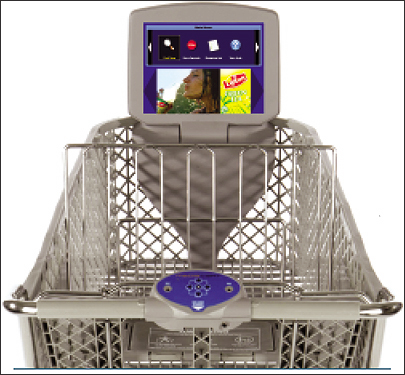Aug 06, 2007By Mary Catherine O'Connor
Why is there a traffic jam in aisle three? What's on sale? And where are all the shopping carts? Now smart shopping carts, fitted with RFID tags and interrogators, are giving retailers new insights into the shopping habits of their customers, while making shopping less of a chore for consumers.
Media Cart Holdings, a retail marketing company, developed an RFID shopping system that's a marketing tool for consumer packaged goods companies and a way for grocery stores to improve shoppers' experiences. ShopRite, a Northeast grocery chain, is currently testing the system at two of its New Jersey supermarkets.

Each shopping cart is outfitted with a ThingMagic 4E RFID interrogator, a power supply and a color monitor. The store shelves are fitted with passive EPC Gen 2 tags from Avery Dennison. As a shopper moves down an aisle, the cart reads the IDs encoded onto the tags and sends them via the store's Wi-Fi network to a central MediaCart database, which sends commands back to the cart's monitor to play select video advertisements.
"The ads are based on the [CPG] firm's desire to trigger certain products based on the customer's location," says Jon Kramer, Media Cart's chief marketing officer. For example, a CPG company might run an ad for cookies when a shopper passes the milk display, or the ad could highlight a special promotion for a particular soda when a shopper enters the soft-drink aisle. The revenue from the ads covers the retailer's cost for the system's RFID infrastructure and software, and the carts cost the same as standard ones.
Consumers can use the system to locate a product by keying in the name on the monitor's touchscreen. Media Cart plans to add a new feature to the system that would allow consumers to create shopping lists at home on the retailer's Web site. In the store, consumers could scan their loyalty card on the cart's bar-code scanner, and the cart's monitor would display the list and guide the shopper from one item to the next.
Intelligentz, an RFID systems integrator, has developed an RFID mapping system that tracks the movement of shopping carts, so retailers can glean insights into consumers' shopping habits. A proprietary 2.45 GHz active tag attached to each cart transmits a unique ID number to RFID interrogators mounted throughout the store. Readers with long-range antennas are mounted outside the store to locate carts in the parking lot. The company's Pangaea RF Pro Web-based software collects the tag IDs over Wi-Fi and plots them on a map. Michael Lucas, CEO of Intelligentz, says a large grocery chain has piloted the cart-tracking application and plans to purchase and roll out the system.
The MediaCart wagon can tell shoppers about special promotions and help them locate items in the store. Maps of store parking lots or the areas surrounding stores—the readers have about a 1-mile range—can enable employees to locate stray carts. In addition, the tags can be set to trigger mechanical pins that lock the wheels when carts near the end of the outdoor readers' range. Intelligentz is partnering with California Shopping Cart Retrieval Corp. to provide the cart-retrieval service to stores.
While these two systems are new, they don't mark the first marriage between shopping carts and RFID tags. In 2001, Sorensen Research began offering its PathTracker system to the retail industry. It analyzes shopping cart traffic patterns. Stores usually install the system for two or three months, often right after a renovation when managers want to gauge the effectiveness of a new layout.
The PathTracker system consists of WhereNet's 2.45 GHz active tags and location sensors, as well as software that Sorensen Research developed to process and analyze the tag IDs that the location sensors collect. Signs posted at store entrances alert consumers that a "tracking technology" is monitoring the movement of shopping carts, says James Sorensen, senior vice president of client services at the research firm. Some consumers are asked to provide feedback about their shopping experiences as they exit the store. With their consent, the ID encoded to the tag on their shopping cart is linked to their interview.
While grocery stores have been the test bed for these RFID-enabled shopping carts, Media Cart's Kramer sees home improvement stores as another strong market.

